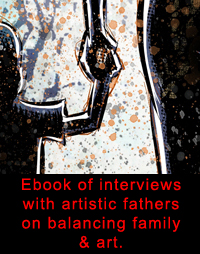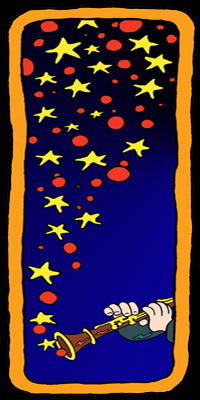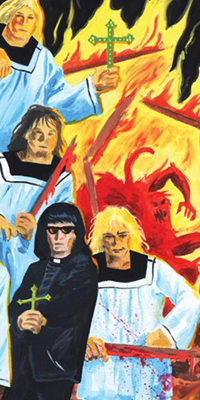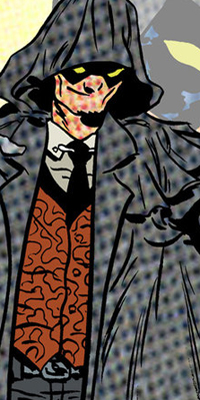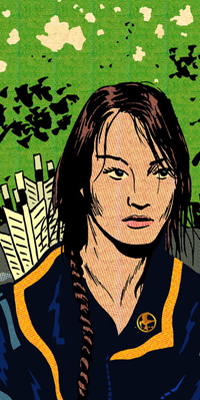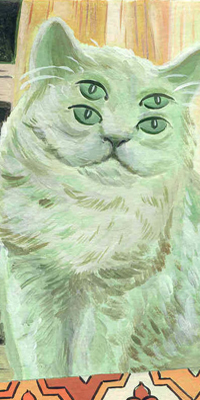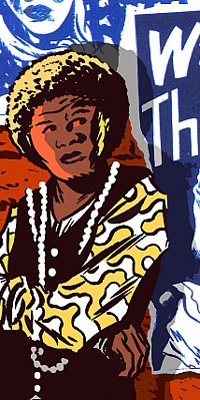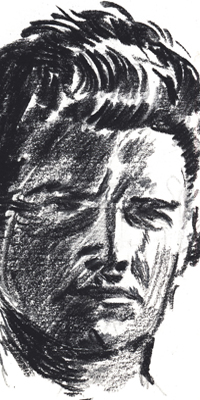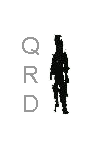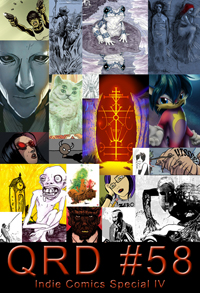
February 2013
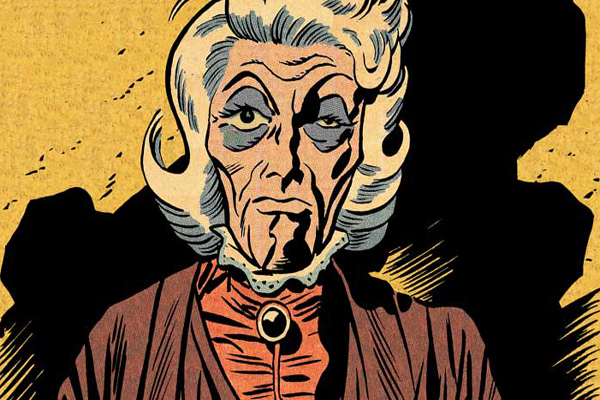
City: Columbus, Ohio
Comics: The Signifiers, The Mesh, Quacky Pig, Freak Cave, The Emotionists, Landlark, The Heat-Seeking Dwarf, This Eternal Flaw
Websites: www.nenoworld.com, www.eventized.blogspot.com, anmgmblog.blogspot.com, twitter.com/Nenofsky
QRD – How old were you when you first got into comics & did you always stick with them or did you come back to them?
Michael – I read my first comics, Carl Barks duck comics & the Tintin graphic novel, King Ottokar’s Sceptre, when I was around six or seven, around 1966. I got into EC horror reprints soon after, then Jack Kirby comics in the early ‘70s. I’ve never stopped reading or creating comics since. What are you, nuts???
QRD – What was the first comic book you ever bought?
Michael – I bought countless illegally packaged comics in the late ‘60s (comics with no covers which were supposed to be destroyed after the covers were returned to the distributor by retailers for credit - but were instead sold in packages of three for fifteen cents.). Tons of Gold Key, Harvey, Metal Men, etc. The first comic book I specifically bought brand new off the rack because I realized it was drawn by Jack Kirby & it wasn’t a reprint, it was brand new Jack Kirby art, published as soon as possible after it came off his drawing board, was Kamandi #13.
QRD – How old were you when you put out your first comic?
Michael – My cousin Tim & I were “publishing” our own comics in the late ‘60s - distributed only to family members. The first comics I published as an adult (if that description applies) were the mini-comics The Moderns #1 & Pictures of Benevolence #1, which I sold through the mail & at conventions. I still keep those Pictures of Benevolence minis in print & plan to draw more. This was in the mid to late ‘80s. My first “real” full-size comic book was Reactionary Tales #1, funded with a Xeric Grant & distributed through Diamond. It was noteworthy to me for a few reasons: it was the debut of my Signifiers Universe, a world that encompasses several different series: The Signifiers, This Eternal Flaw, Landlark the Heat-Seeking Dwarf, Larvae Boy, Emperor of the Insect World, & The Emotionists. Reactionary Tales also featured a written & drawn introduction by cartoonist Paul Pope. (Paul has drawn some Signifiers Universe art as well, which I’ll be printing in future issues of The Signifiers.)
QRD – What decade do you think produced the best comics?
Michael – For comic strips: a tie between the 1920s & 1930s. For comic books: no other decade advanced the medium, both overground & underground, as much as the ‘60s. For graphic novels: the ‘80s.
QRD – Why comics instead of just writing or drawing?
Michael – Or filmmaking? It can be done cheaply; the comic creator has total control over the final product; the comics creator is responsible for every aspect of the storytelling: pacing, body language, costume design, theme, plot, editing, etc. Also, as with every medium, there are things that can be done with comics that can’t be done with anything else. Its unique properties are prime tools for storytelling.
QRD – Do you see mini-comics & indie comics as paths to mainstream comics or as their own unique media?
Michael – They can be paths to mainstream comics. It depends on what you want to do. Few cartoonists want to pigeonhole themselves or categorize/limit themselves & I certainly don’t. Why not do it all? Look at a cartoonist like Jim Woodring. He’s drawn for an animation company (working alongside Jack Kirby), written & drawn his own indy comic book, Jim, designed toys, written scripts for comics based on Freaks & Alien & also paints. Why limit yourself to any one genre, technique, outlet or format? There’s a whole world of opportunities out there. Many indy cartoonists do their self-owned work & do assignments for mainstream companies.
QRD – How many copies of your comic do you print in your first run?
Michael – The first printing of my most recent comic, The Signifiers #2, was only 500 copies. Storage space is getting to be an issue! Besides, like Doritos, we can make more.
QRD – How much do you think comics should cost?
Michael – I don’t really think about costs too much as long as it’s not crazy or blatantly unfair. I don’t mind paying more for cartoonists whose work I really like or for books which I know have a limited print run. I know firsthand that those cartoonists are trying to make a living off their work & I expect to pay more for something that’s not mass-produced in huge quantities like an X-Men comic.
QRD – How many books do you produce a year & how many would you like to?
Michael – The past year I published one comic book, one coloring book (going back for a second printing today) & the first in a new line of Underwater Cats greeting cards. It’s tough to find time to create & publish more comics because I’m now a self-employed creator.
While I was drawing comics to publish this past year I also illustrated a new pulp short story collection for Airship 27, designed a poster for the play The History Boys for Available Light Theatre, inked a comic book cover penciled by Javier Hernandez & colored by ex-Marvel editor Mort Todd, drew tons of art for Kickstarter incentives, created graphics for a startup arts organization in Oklahoma, helped design & painted signs for a church, drew a pinup & a cover for Jamie Gambell’s comic series The Hero Code, wrote an e-Book (to be published soon) on drawing comics old school style, illustrated fiction for the anthology The American Zig-Zag Vol. II, painted a cover & began illustrating a new story for Nix Comics Quarterly, designed concert posters, drew commissioned comic book covers for private collectors, & began serializing new Emotionists material on WordPress: www.nenoworld.com/SignifiersUniverse
There are probably some other projects that aren’t coming to mind.
To answer your question, I’d like to publish many, many more comics!
QRD – Do you think stories should be serialized or delivered as complete works?
Michael – Doesn’t need to be one or the other. Some works should be released as complete (can you imagine if Blankets had been serialized? Wouldn’t work). Other stories work fine serialized & I love the inherent suspense & art & craft of the serialized form. I’m not the only one. Since Charles Dickens, audiences have embraced the serialized form & relatively recent TV series like Lost, Breaking Bad, & The Wire have shown there’s still a hunger for this kind of storytelling. In fact, many TV series nowadays get dinged by the critics if they’re NOT serialized.
QRD – How are comic strips different than comic books & which medium do you prefer?
Michael – Since there’s theoretically an infinite amount of room in a comic book & a pathetically small space to tell a story in today’s syndicated comic strip world, I prefer comic books. Online comic strips are a different ballgame though; this format blurs the line between comic strips & comic books &, like comic books, the playing field is infinite.
QRD – How long is it from when you start a comic until it’s printed?
Michael – In my crazy world, with my crazy schedules, it can take up to a year! Left in a room with no other responsibilities, it would probably take a month or less. I try to make it up to the readers with more material when printed, though. My new issue of The Signifiers, for example, has an interview with cartoonist Tom Scioli about the current state of comic book distribution along with previously unpublished Scioli artwork. The Signifiers #3, published as soon as I can finish it, will be squarebound & at least 100 pages of serialized stories, stand-alone stories, & a long cartoonist interview.
QRD – What do you do better with your comics now than when you first started?
Michael – I can draw comics faster now, with no loss in quality (that I can see). I feel more confident in my abilities now, so the work gets done faster with less correcting mistakes. To get it done right the first time you have to understand the structure & mechanics of what you’re drawing. If the pencils aren’t correct & complete, good luck with the inking. I’m very much looking forward in 2013 to experimenting with Manga Studio & some other apps that have possibilities for more quick, spontaneous execution & formatting.
QRD – Do you do thumbnails?
Michael – Always. It’s in this stage that you have to figure out the camera angle, lighting & design of the panel, the shape of the panel, & the shape of the page.
QRD – At what size do you draw?
Michael – I draw different sizes for different projects. My stories for The Signifiers & Nix are drawn standard size. My first Larvae Boy was drawn Golden Age style (the huge norm until 1968). My series This Eternal Flaw, though, was drawn tiny & then blown up for mini-comic size, creating a very nice texture.
QRD – What kind of pens do you use?
Michael – I don’t use pens, except for a Rapidograph pen for panel borders & lettering. My art is mostly drawn with a variety of brushes & a variety of brands of India Ink.
QRD – What does your workstation look like?
Michael – A mess until I clean it up for starting a new project! I need a large area to spread out my resource materials & any tools I may need at a seconds notice. It’s all set up next to my turntable, as I listen to tons of vinyl while drawing (as well as podcasts, etc.).
QRD – At what point in the artistic process do you work digitally?
Michael – Again, it depends on the project. A lot of my work that gets published is all hand drawn, then scanned in, digitally cleaned up, & formatted for print. My comic strip The Mesh is colored in Photoshop. My comic strip Freak Cave is nearly all digitally drawn & painted, based on squiggly little line drawings. Most of the posters I’ve created were all digitally created.
QRD – What do you think of digital comics & webcomics?
Michael – The biggest problem is there’re too many good ones to read. We’re living in an amazing world of entertainment. You could spend every waking moment reading webcomics & still not get to all the good ones. I love webcomics. For the ones I love the most, though, I like to see them published. That seems to be the consensus. There is a market demand for the most popular webcomics to ultimately be published in book form.
QRD – Do you prefer working in color or black & white?
Michael – It depends on the project. I love black & white & I love color. The theme, the feel, the atmosphere of a story should the deciding factors of whether a story should be in color or black & white. I wouldn’t want to see Gone With the Wind in black & white or The Maltese Falcon in color.
QRD – How do you find collaborators?
Michael – These days I usually don’t! My schedule’s so busy I don’t have time to even think about it. Those who want to work with me are welcome to contact me. I do like collaborating.
QRD – How tight do you think a script should be as far as telling the artist what to draw?
Michael – Like a film director who allows an actor the freedom to act, I think scripts should tell everything that’s essential while allowing the artist room to help create the look of the story.
QRD – What comic book person would you be most flattered to be compared to?
Michael – A tie between Milton Caniff/Frank Robbins/Jack Kirby although, of course, I’m nowhere near as good as any of those gents.
QRD – What do your friends & family think of your comics?
Michael – I get good feedback, but I’m hardly their favorite cartoonist. My wife likes Persepolis, Sheldon, & nearly anything by Tezuka & Joss Whedon. I know 12-year old kids that love Ditko & Kirby comics. It’s a good world now for comic readers.
QRD – What do you think of superheroes?
Michael – I love them, when written & drawn well. I love practically anything that’s written & drawn well, regardless of genre: crime comics (hint: read Fatale, Thief of Thieves, & Near Death), romance comics, westerns, autobio, funny animals, Mike Kupperman’s Tales Designed to Thrizzle, horror comics (The New Deadwardians, The Walking Dead, etc.).
QRD – Marvel or DC?
Michael – The 1930s go to DC. The ‘40s through the ‘70s go to Marvel. DC gets the ‘80s & ‘90s & since the turn of the century it’s been a tie, with great comics & poor editorial decisions on both sides of the aisle.
QRD – What comic characters other than your own would you like to work with?
Michael – Captain America, Machine Man, The Fantastic Four, The Spectre.
QRD – What conventions do you try to attend & why?
Michael – I’ve never missed SPACE (Small Press & Alternative Comics Expo), the premiere midwest show for self-publishing cartoonists. I want to get back to HeroesCon this year. I attend & set up at many local Ohio shows, though not Mid-Ohio-Con, which has now been bought by Wizard Whirled.
QRD – What do you do to promote your books?
Michael – The usual suspects: Twitter, Facebook, press releases, review copies, my blog, interviews...
QRD – Do you think your comics are well suited to comic shops or would sell better elsewhere?
Michael – Because the town I live in, Columbus, Ohio, is very music-centric, I sell my comics in as many record stores as comic book stores. They are sold in other comic shops nationwide, though. The postage costs for getting comics to retailers outside of Diamond is an issue, though, which is why I’d love to see more of a concerted, organized effort for retailers & self-publishing cartoonists to make retailing deals at conventions. After all, we’re all there in the same room, no postage required & the retailers there have access to comics they just can’t order through Diamond.
QRD – What other medium would you like to see some of your comics made into (television, film, games, action figures, etc.)?
Michael – Animation & games. Although a Val Crocodile, Associate Professor of Linquistics action figure could be cool.
QRD – Do you consider yourself a comic collector or a comic reader or both?
Michael – I only buy comics I love to read & I do love to read!
QRD – What do you see as the most viable mediums for comics distribution 10 years from now?
Michael – Technology changes so fast, it’s nearly impossible to guess how comics will be distributed three years from now, let alone ten. Ten years from now comics may be beamed directly into your brain or, at least, read on your online Google contact lenses. I like to think there will always be a place for paper comics, though.
QRD – What would you like to see more people doing with comics?
Michael – Uh… what sort of things do you suspect people are doing with their comics? I guess I’d like to see more people reading their comics!
Oh, you mean creators. More honest, heartfelt, thoughtful, genre-expanding, fun, cosmic, experimental work would be good. Less mandatory “events” in the mainstream comics would me nice, too. Much less. It wrecks the continuity of series stories.
QRD – Anything else?
Michael – Thanks for letting me ramble. To readers: try comics outside of your comfort zone. Some of the best work is being created outside of the Big Two.






